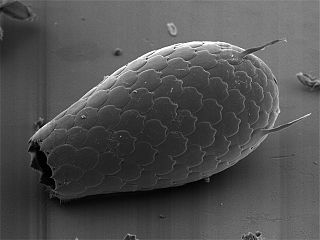
Cercomonads are small amoeboflagellates, widespread in aqueous habitats and common in soils.

The sarcomonads or class Sarcomonadea are a group of amoeboid biciliate protists in the phylum Cercozoa. They are characterized by a propensity to move through gliding on their posterior cilium or through filopodia, a lack of scales or external theca, a soft cell surface without obvious cortical filamentous or membranous skeleton, two cilia without scales or hairs, tubular mitochondrial cristae, near-spherical extrusomes, and a microbody attached to the nucleus.
Proleptomonas is a genus of coprophilic protists, containing the single species Proleptomonas faecicola. It belongs to the phylum Cercozoa, although it was previously considered the only free-living kinetoplastid. It is the only member of family Proleptomonadidae.

Thaumatomastix is a protist genus of the order Thaumatomonadida, within the phylum Cercozoa and the class Imbricatea. Its species are aquatic, feeding on algae and appearing in waters of a wide range of temperatures and salinities, and are 15-50 micrometers long. They can interchange between flagellated and amoeboid forms, and are notable for being covered in both spiny and flattened siliceous scales.

Katabia is a genus of soil-dwelling heterotrophic flagellate cercozoans containing the single species Katabia gromovi, and the only member of family Katabiidae.

Parvilucifera is a genus of marine alveolates that behave as endoparasites of dinoflagellates. It was described in 1999 by biologists Fredrik Norén and Øjvind Moestrup, who identified the genus among collections of Dinophysis dinoflagellates off the coast of Sweden. Initially mistaken for products of sexual reproduction, the round bodies found within these collections were eventually recognized as sporangia, spherical structures that generate zoospores of a parasitic protist. This organism was later identified as P. infectans, the type species. The examination of this organism and its close genetic relationship to Perkinsus led to the creation of the Perkinsozoa phylum within the Alveolata group.

The vampyrellids, colloquially known as vampire amoebae, are a group of free-living predatory amoebae classified as part of the lineage Endomyxa. They are distinguished from other groups of amoebae by their irregular cell shape with propensity to fuse and split like plasmodial organisms, and their life cycle with a digestive cyst stage that digests the gathered food. They appear worldwide in marine, brackish, freshwater and soil habitats. They are important predators of an enormous variety of microscopic organisms, from algae to fungi and animals. They are also known as aconchulinid amoebae.
Michael Melkonian is a German botanist and professor of botany at the University of Cologne.
Platysulcus tardus is an eukaryotic microorganism that was recently discovered to be the earliest diverging lineage of the Heterokont phylogenetic tree. It is the only member of the family Platysulcidae, order Platysulcida and class Platysulcea.

Vampyrella lateritia is a freshwater species of predatory amoebae that feeds on species of algae and is known for its specialized feeding strategy of removing, digesting, and ingesting the cellular contents of its prey. It is the type species of the genus Vampyrella and has been identified in numerous locations around the world including Brazil, Germany, and the eastern United States. Along with Vampyrella pendula, its genome was sequenced in 2012.
The paracercomonads are a group of cercozoan protists. Taxonomically, they comprise the family Paracercomonadidae, order Paracercomonadida and subclass Paracercomonada. Due to their morphological similarities to the cercomonads, members of this family were grouped with Cercomonas and similar taxa from the beginning. However, their similarities are due to convergent evolution.

Ventrifilosa is a highly diverse group of phagotrophic protists that glide through their flagella and emit filose pseudopods from their ventral side for feeding. Because of their mixture of amoeba and flagellate characteristics, they are amoeboflagellates. Members of this group are the Imbricatea, Sarcomonadea and Thecofilosea.
Minimassisteria is a marine bacterivorous genus of protists with only one species, M. diva, that presents three different lifestyle forms. It has a widespread geographic distribution. It is an amoeboflagellate most closely related to Massisteria, and together comprise the family Massisteriidae.

The glissomonads are a group of bacterivorous gliding flagellated protists that compose the order Glissomonadida, in the amoeboflagellate phylum Cercozoa. They comprise a vast, largely undescribed diversity of soil and freshwater organisms. They are the sister group to cercomonads; the two orders form a solid clade of gliding soil-dwelling flagellates called Pediglissa.
Pediglissa is a subclass of phagotrophic protists that inhabit soil or freshwater habitats. They were defined in 2018 according to phylogenetic analyses that showed a clade containing the orders Cercomonadida and Glissomonadida. They're the sister group of Paracercomonadida.

Viridiraptoridae, previously known as clade X, is a clade of heterotrophic protists in the phylum Cercozoa. They're a family of glissomonads, a group containing a vast, mostly undescribed diversity of soil and freshwater organisms.

Orciraptor is a genus of heterotrophic protists, containing the single species Orciraptor agilis. It belongs to the family Viridiraptoridae, in the phylum Cercozoa.
The pansomonads, suborder Pansomonadina, are a group of heterotrophic protists that belong to the phylum Cercozoa. Some of them are helioflagellates, with characteristics of heliozoans and amoebo-flagellates.
Rhogostomidae is a family of thecate amoebae with a ventral cleft-like aperture. Their theca is thin and flexible and adheres to the cell. The cleft-like aperture allows them to extend and retract their filose pseudopodia, which they use to move and feed. They are primarily feeding on bacteria, but they are also known to consume yeasts and algae. The family contains three genera: Capsellina, Sacciforma, and Rhogostoma.

An amoeboflagellate is any eukaryotic organism capable of behaving as an amoeba and as a flagellate at some point during their life cycle. Amoeboflagellates present both pseudopodia and at least one flagellum, often simultaneously.







